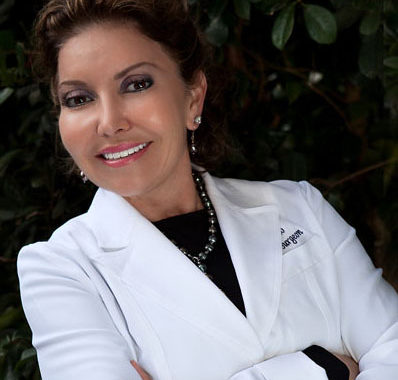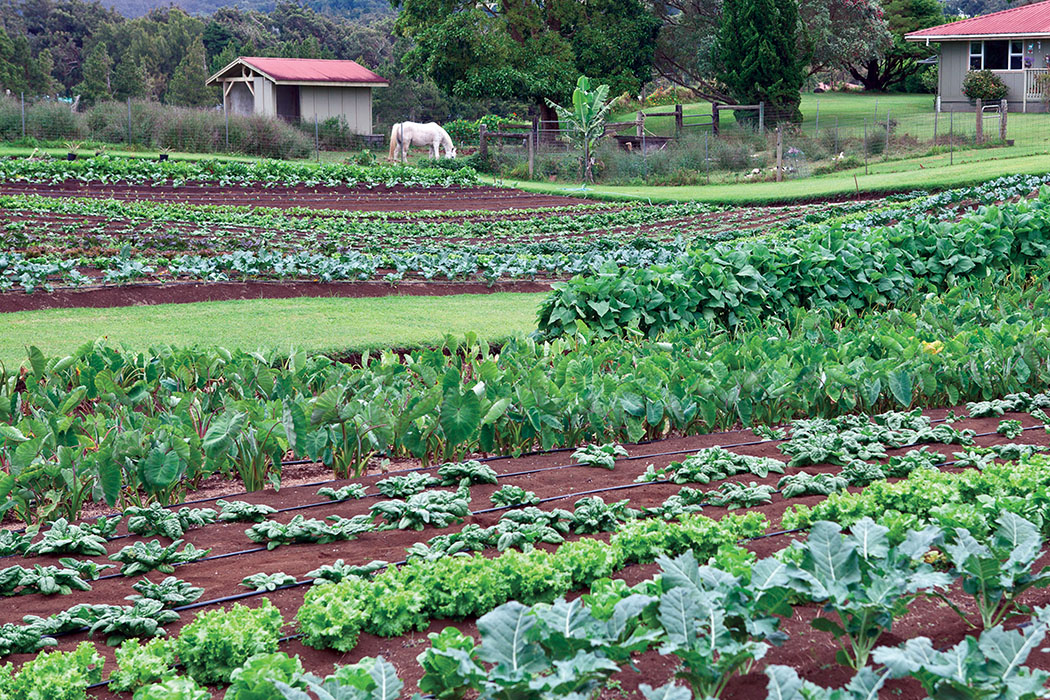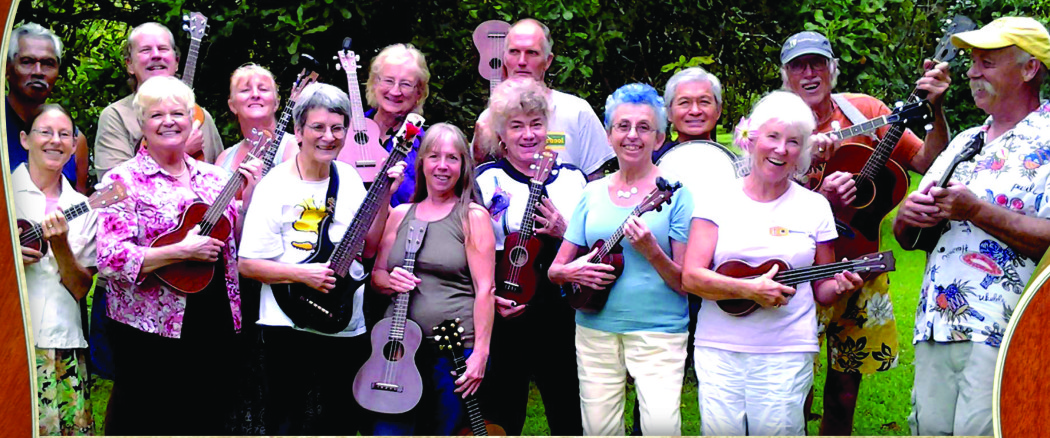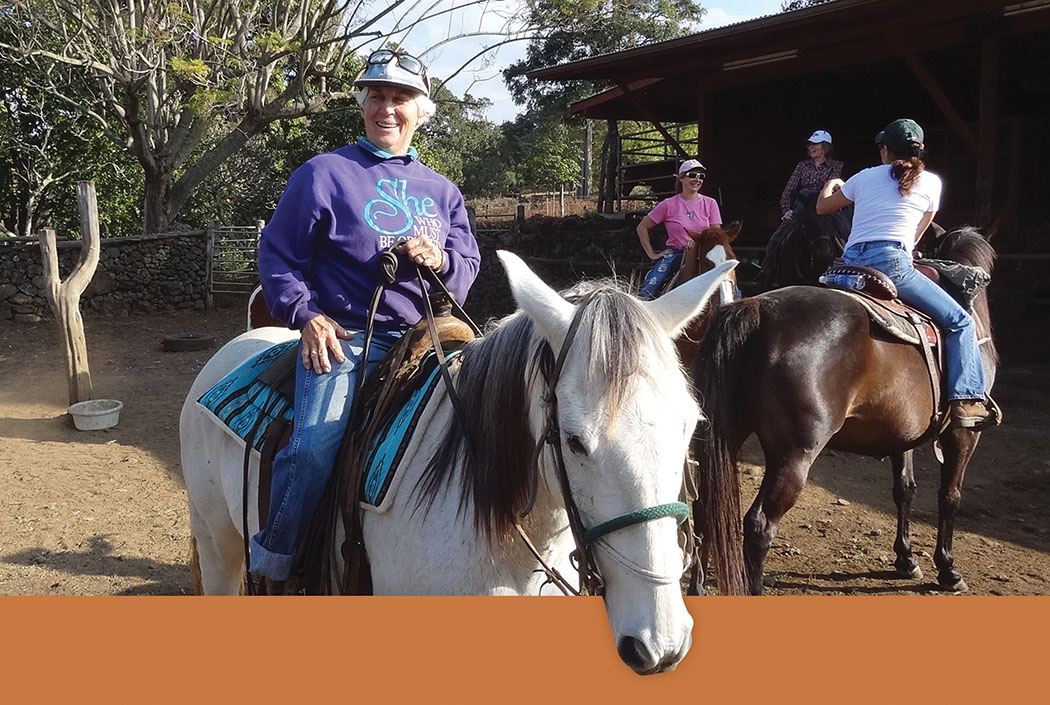
Kama‘āina Land Child: Barbara Kamilipua Nobriga
 By Denise Laitinen
By Denise Laitinen
Look up the word kama‘āina in the dictionary and chances are you won’t see Barbara Nobriga’s name and photo. But you should. Literally translated, kama‘āina means land child. According to the hardcover edition of the Hawaiian Dictionary by Mary Kawena Pukui and Samuel H. Elbert, kama‘āina is defined as “native born, one born in a place, host.”
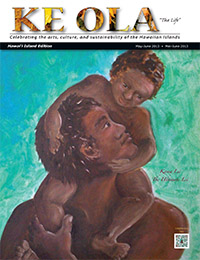
And that pretty much sums up Barbara Kamilipua Nobriga.
She is the fourth generation to work land granted to her family by Kamehameha IV—land that is adjacent to Pa Nui, built by Kamehameha the Great, and was the first cattle pen in the state.
Her family members were instrumental in the building of Lanikila Congregational Church in the 1860s. A hotel on the property run by her grandparents was host to the Queen of Sweden and celebrities. Indeed, Queen Lili‘uokalani, King David Kalākaua, and author Jack London have sat around the massive koa dining table that is now used in her mountain retreat, located at the upper elevations of the property.
A relative of Ikua Purdy, Hawai‘i’s most famous cowboy, Barbara is one half of the only mother-daughter duo inducted into to the Paniolo Hall of Fame (her mother, Kapua Heuer was inducted in 2000, and Barbara was inducted in 2004.)
A 4-H leader, pā‘ū rider, rancher, Daughter of Hawai‘i, Kona Historical Society, and head of the King Kamehameha Day Parade, Barbara is committed to perpetuating the paniolo culture of Hawai‘i Island. Over the years she has received numerous awards including Rancher of the Year by the Kona Soil and Water Conservation district in 1999.
December 2012, Barbara was named the Grand Marshall of the Kona Christmas parade. Four generations of her family rode in the parade, including 10 of her 14 grandchildren (two were competing in the World Series of Roping on the mainland).
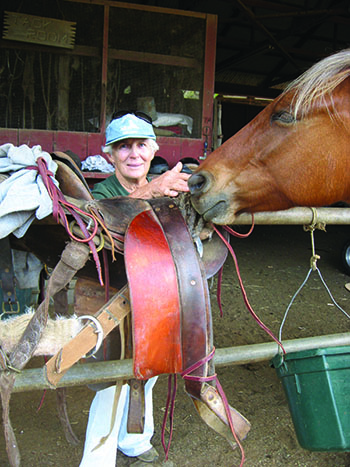
After decades of working the land, shoeing horses, branding cattle, mending fences, and raising a family, one wouldn’t blame Barbara for taking it easy and resting in her historic makai home built more than 100 years ago.
It’s an impressive home that harkens back to the Hawai‘i of old filled with antique koa furniture and handwoven lauhala mats for area rugs.
You won’t find Barbara resting. She’s on the phone with the vet about a donkey that requires medical attention. Then it’s off to the stables to check on horses. The ranch operates Holo Lio Trail Rides, offering twice-daily rides on the slopes of Hualālai.
In the early afternoon, kids will start arriving for their horse riding lessons. Later in the day, her grandkids will practice roping cattle in preparation for an upcoming rodeo competition. Then there is the orchard of cacao trees her family is in the middle planting—an effort to diversify their agricultural lands. In addition to all of this, Barbara is preparing for a talk she’ll give later in the week on the history of Keauhou.
For the moment, Barbara is gracious enough to take a break from the organized chaos that is ranching life and talk about her saddle that was already old when she “borrowed” it from the saddle house 50 years ago. It remains the only saddle Barbara likes to use.
“I myself ride nothing but a Hawai‘i tree [saddle]. It’s the most comfortable saddle out there.” Made of Neneleau tree, it’s very light, indeed.
Her daughter says that at some point the saddle will have to go in a museum. “Not as long as I’m in it,” laughs Barbara.
Paniolos on Hawai‘i Island date back to 1833 when three vaqueros—Spanish/Mexican cowboys—arrived at Kawaihae Harbor to teach Hawaiians how to rope and herd cattle and ride mounted horses. Over the years paniolos developed their own style of saddle making, called a Hawaiian tree saddle, so named because cowboys went into the forests and cut the tree, which they carved into a saddle. (See Ke Ola magazine July/August 2011 issue The Art of Noho Lio o Paniolo: Making Hawaiian Tree Saddles.)
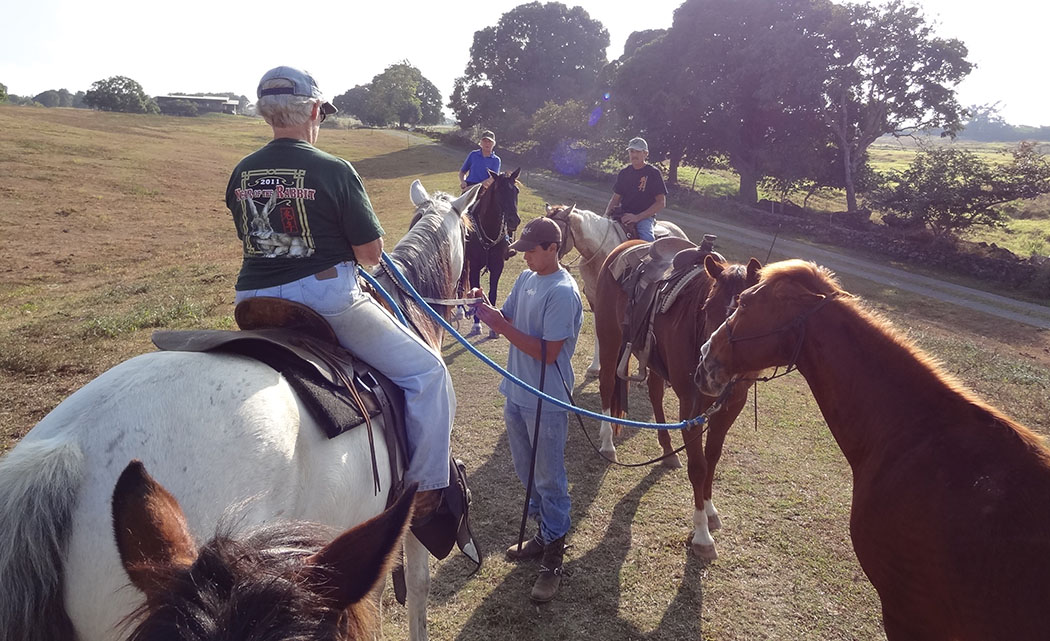
When people think of Kona, many think of coffee or fishing or the ocean. Most never go beyond the coffee belt to realize the agricultural nature of Kona. And it is that agricultural nature that is the very essence of Barbara.
Her great grandmother, Eliza Roy, was granted land from King Kamehameha IV. At one time, it extended all the way from the 4,500-foot elevation to the ocean. The land is adjacent to Pa Nui, the famed wall built by King Kamehameha I. Encompassing 460 acres the wall was five feet wide and nine feet tall.
The Great Kamehameha Wall is still pretty much intact and is used as a boundary wall. It can be seen during the trail rides through the ranch. It still is in some places, even though earthquakes, wild animals, and the passage of time have taken their toll.
Cattle were first brought to Hawai‘i in 1793 by British captain George Vancouver as a gift to King Kamehameha I. The king placed the cattle in the pen and declared them kapu—meaning they could not be hunted or killed. Multiplying rapidly, the cattle were able to sufficiently knock down parts of the wall to the point that they escaped and wreaked havoc on the countryside, tearing up gardens and terrorizing villages. Thirty years later, King Kamehameha III lifted the kapu and brought Mexican vaqueros to Hawai‘i to teach Hawaiians how to work the herds, tan hides, and make saddles. Barbara points out that Hawaiians already knew how to ride horses and cows by the time the vacqueros arrived.
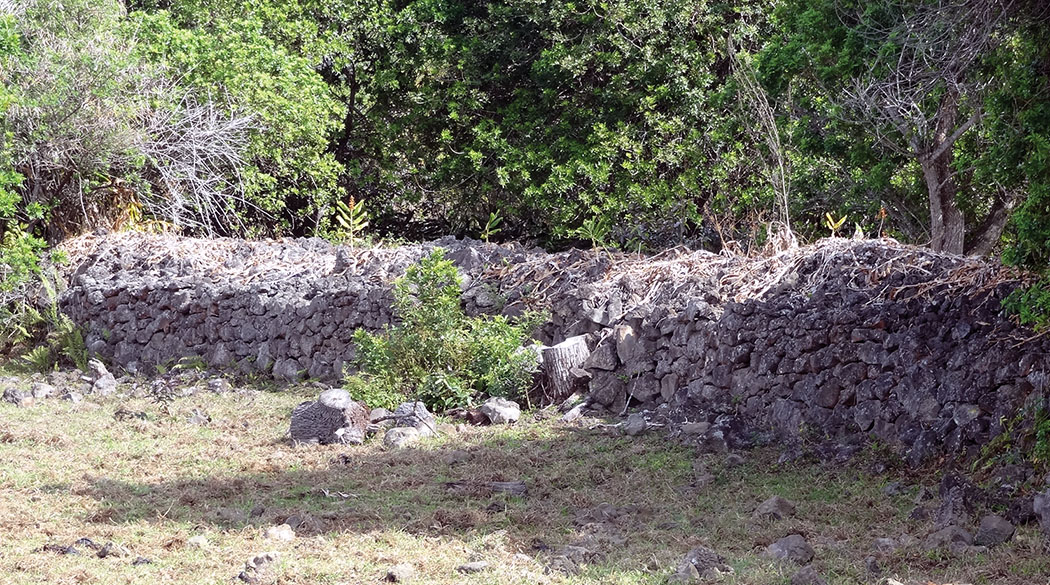
In the 1860s Barbaraʻs great-grandparents built their mauka home, named Waihou, on land bordering the cattle pen. It’s in an area named Lehuula, adjacent to Kainaliu located three miles above Māmalahoa Highway. Barbara’s daughter Lilinoe and her family now reside in the home they built on the old house site.
The great-grandparents makai home, also built in the 1860s, was located on the mauka side of Māmalahoa Highway near Kainaliu. After her great-grandparents passed away, Barbara’s grandparents opened it as the Mahealani hotel, also known as the Wall Hotel. It served people from all over the world from its opening in 1913 until it closed in 1932 when the Kona Inn was in full operation and patrons chose to stay near the ocean. Barbara’s daugher Kuulani and her family live in the home they built on the old hotel site.
The house where Barbara and her husband Edwin live today was built in 1904 next to the hotel. Elsewhere on the family land their daughters, Manu and Buggins, and son Edwin have built homes and are raising their families. Edwin handles the heavy equipment for land clearing and hauls water—for the ranch and for customers needing potable water.
Barbara’s grandmothers and great grandmothers were pure Hawaiians who married men who came to Hawai‘i. Her mother’s grandfather, William Franklin Roy, came from Scotland, and her great great grandfather John Davis came from Wales.
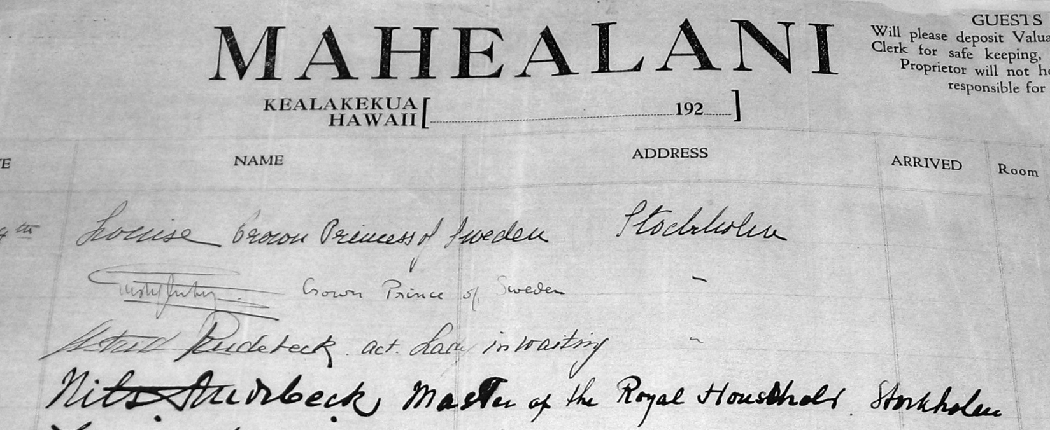
On the maternal side of her family, Barbaraʻs grandfather came to Hawai‘i at the age of 18.
“He and his uncle Charlie leased thousands of acres of land upcountry near Umi’s Temple in Kanahaha, up on the flat lands of Hualālai, about 12 miles above what is now Māmalahoa Highway.”
“My grandfather went to the mainland to study accounting and Uncle Charlie thought he wasn’t coming back so he sold the land to a French public health doctor, George Trousseau, who in turn sold it to W.H. Greenwell. That started the Greenwell ranching.”
Over the course of generations land has been added and divided, and yet is still intact.
Barbara and Edwin raised five children on this land. All of them attended college and each returned, building their own homes on the family property. Barbara’s great granddaughter, Makamae Jewell, is the seventh generation to live on the land.
Although technology and modern advancement have changed some things—there’s no longer a need for a butter room—much of the paniolo way of life continues today as it did for Barbara’s ancestors in the 1860s.
When talking about the future of ranching in Hawai‘i, and the west side of Hawai‘i Island in particular, she admits, “It’s challenging.”
Kona has a history of weather not cooperating. Cattle was on the land until about 1898 when a lot of Kona, Hōnaunau, and Captain Cook became sugar cane agriculture. There was a railroad track to transport the sugar. (The railroad track is about two miles makai of Barbaraʻs house along the highway and ends at Hualālai road.) Sugar cane only lasted until 1927, because Kona was being Kona—she rained when she wanted to rain—and the sugar was not getting enough water. Now the land has turned back into ranching again.
Noting that parts of West Hawai‘i have been in a drought for 40 years, Barbara says, “It’s difficult to raise cattle in a drought. You should be taking the cattle to the grass not the grass to the cattle. Hopefully we’re in the tail end of a cycle now, even though 2011 and 2012 went down in history as the driest years.”
These days much of the cattle raised on their land is sold to cattle brokers who ship the animals to the mainland. “If you don’t have grass, you can’t fatten them so you have to sell the cattle when they are young.”
She sees diversification as the key to survival. Through Holo Lio Stables, her ranch has offered trail rides for 40 years. They offer well-trained horses for beginner and advanced riders to ride upland through open pasture and native forest. The ranch also boards horses and rents the arena.
“We’re planting an avocado orchard and an orchard of cacao trees. That’s what is going to carry you through. When one is slow the other will pick up.”
“They [her grandkids] shouldn’t count on the ranch to make a living, but they could do it as a side business. I think that the people of Hawai‘i need to acknowledge the fact that we need to develop an independence to importing food from the outside.”
“We certainly have the lands available to produce food here but [people] have to quit taking our ag lands and turning them into cookie cutter houses. We have a lot of waste lands that can be used for that, but stay out of our breadbasket.”
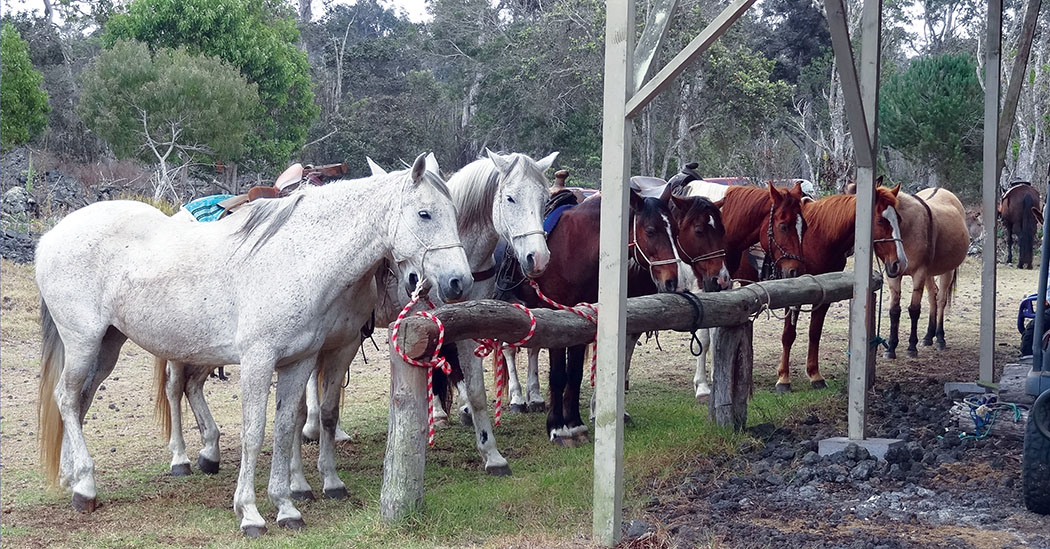
Ranching is a participatory business—everyone pitches in. The horses all go to work whether it is trail riding or competing at a rodeo. “They have to earn their keep.” Even the cats and dogs have to earn their keep—catching mice and herding cows.
All five of her children and her 14 grandchildren (three are in school on the mainland) live close by on family lands. Although her kids and grandkids do other work for a living, they all help out on the ranch.
Once a month the entire family, about 30 people, gets together, “No excuses,” says Barbara. “It’s a work day—a family work day. We do anything from branding cattle to pulling weeds to building fences.”
One final note that people should know about the ranch. “It’s all family owned. It’s historic. It has never changed hands and probably never will.” ❖
Contact Barbara Nobriga: bnobriga@hawaiiantel.net
To schedule a trail ride: HoloLio.com
To order potable water: LoaaWater.com
Contact writer Denise Laitinen: wahineokekai@yahoo.com
